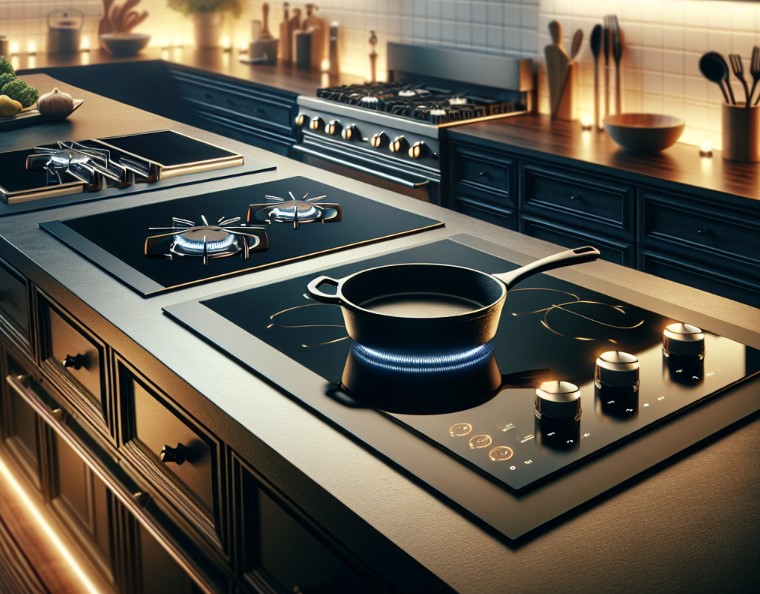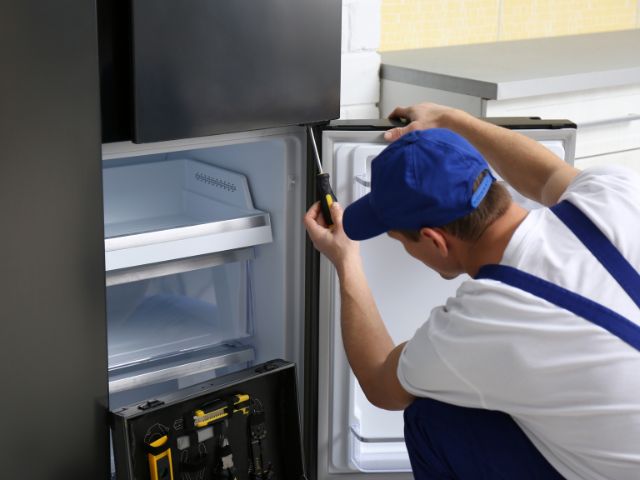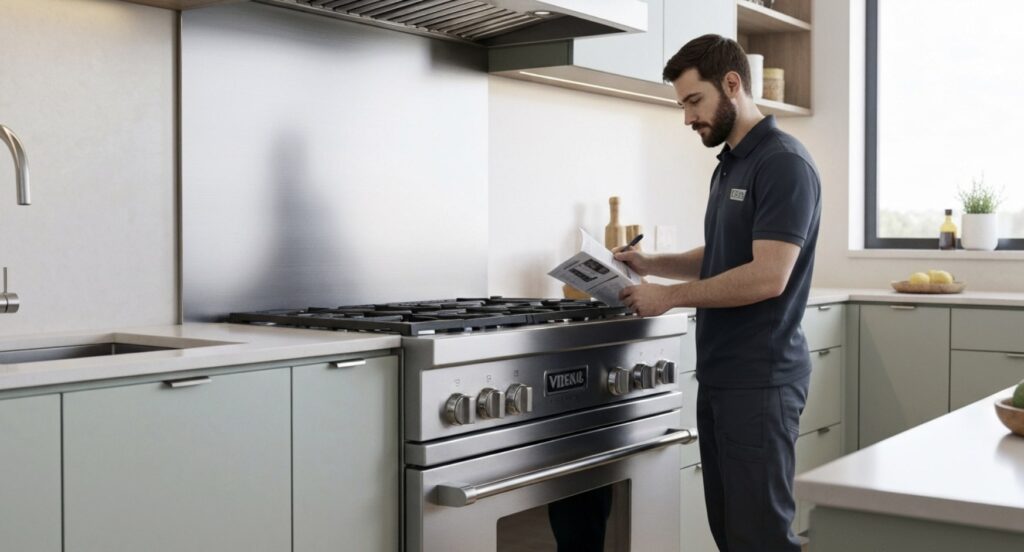Choosing the perfect range for your kitchen can be a daunting task. With Induction vs Gas vs Electric Range options available, it’s essential to weigh the pros and cons of each to find the ideal fit for your cooking style and preferences. This guide will delve into the key differences, helping you make an informed decision that enhances your culinary experience.
Understanding Different Types of Ranges
Before we look closely at each type of range, let’s understand the basics. Each type of range has special features that fit different cooking styles and preferences.
The Basics of Induction, Gas, and Electric Ranges
Induction cooking works on an interesting physics concept. The induction range creates an electromagnetic field. This field interacts with iron or steel cookware, making it heat up directly. Since the heat is made inside the pot or pan, induction cooking is very energy-efficient and quick.
Gas ranges use a traditional method. They have a flame beneath the cookware to create heat. Gas ranges allow cooks to see the flame, making it easy to change the intensity. Though gas ranges are not as energy-efficient as induction, they are good for precise temperature control and quick responses.
Electric ranges heat coils to transfer heat to the cookware on top. Electric ranges with exposed coils are often cheaper. Meanwhile, smoothtop electric ranges look modern and sleek. They may take a bit longer to heat than gas or induction, but they give steady and reliable heat for different cooking tasks.
Key Differences and How They Affect Cooking
One of the biggest differences between these types of ranges is their heat source. This affects your cooking experience. Induction ranges heat up the fastest. Next is gas ranges, followed by electric ranges.
- Induction Range: It gives exact temperature control. It heats evenly and uses less energy. You need to use induction-compatible cookware with it.
- Gas Range: Many people like it because it heats up quickly. It offers control over the flame and feels familiar to cook with. However, it is not as energy-efficient as induction.
- Electric Range: This type is easy to use and clean. It is often the cheapest choice. But, it can be slower to heat up and cool down compared to the other types.
Choosing the best range for you depends on how you cook, your budget, and what you prefer. Looking at the good and bad sides of each type can help you find the one that fits your needs best.
Preparing for Your Range: What You Need to Know
Choosing the right range is only the first step. Before you begin cooking, think about a few important things. These include the equipment you need and the installation rules. Knowing these details will help you be ready to enjoy your new range fully.
Essential Equipment for Each Type of Range
For induction cooking, you need magnetic cookware. Only pots and pans with a magnetic base can work on an induction range. To check if your cookware is magnetic, see if a magnet sticks to the bottom.
Gas ranges do not need special pots and pans, but some tools can make cooking easier. A cast-iron skillet helps with even heat, and a wok ring keeps round-bottom woks stable on the burner.
Electric ranges work well with most cookware. Still, you should avoid pots and pans with rough bottoms. They can scratch the smooth surface of electric ranges. Choosing flat-bottomed cookware helps with heat transfer and keeps the surface safe.
Installation Requirements and Safety Tips
Installation needs and safety precautions are paramount for each range type. Understanding these differences is vital for a smooth transition and safe cooking environment.
|
Range Type |
Installation Needs |
Safety Tips |
|
Induction Range |
240-volt electrical outlet (professional install often needed) |
Use only induction-compatible cookware; keep magnets away |
|
Traditional Gas |
Gas line connection (professional install required) |
Ensure proper ventilation, never leave flames unattended |
|
Electric Range |
240-volt electrical outlet (professional install may be needed) |
Avoid using damaged cookware, keep flammable materials away |
Always consult qualified professionals for installation and adhere to the manufacturer’s safety guidelines for your specific range model.
Beginner’s Guide to Using Induction Ranges
Induction ranges are very efficient and safe, but they might look hard to use at first. Once you know how they work, you’ll be cooking tasty meals easily.
Step 1: Choosing the Right Cookware
The secret to good induction cooking is using the right cookware. You need pots and pans that have a magnetic base to use on an induction range. Luckily, there are many options made just for induction cooking available today.
When you shop for induction cookware, check for the induction symbol. This symbol looks like a coil and can be found on the bottom or the packaging. Materials that work well for induction include cast iron, enameled cast iron, and magnetic stainless steel.
To check if your current cookware works with induction, use a magnet. If it sticks tightly, your cookware is fine. If not, you should think about getting new pots and pans made for induction cooking.
Step 2: Understanding Induction Cooking Settings
Once you have the right cookware, knowing your induction range settings is very important. Unlike regular stoves, induction cooktops do not show flames or heating parts. They use touch controls or knobs to change the temperature and power levels.
Many induction ranges have preset cooking modes. These include boiling, simmering, frying, and melting. Each mode changes the power output to set levels, making it easier to get the results you want. If you want more control, you can also change the power level manually.
Remember, induction ranges react quickly to temperature changes. When you adjust the setting, the heat changes almost right away. This gives you better control while cooking. Start with lower power levels and then turn it up slowly to prevent burning or overcooking your food.
Getting Started with Gas Ranges
Gas ranges are popular because they offer instant heat control and a familiar way to cook. But they need a different approach than induction or electric ranges. Before you light those burners, let’s go over how to get started with gas.
Step 1: Safety First – Checking Gas Connections
Before you use your gas range for the first time, make sure all gas lines are tight and have no leaks. Start by finding the gas shut-off valve, which is usually located behind the range. Get to know how it works so you can turn off the gas quickly if there’s an emergency.
After you find the shut-off valve, check for leaks. Mix some dish soap with water to make a soapy solution. With the gas on, apply this soapy mixture to all gas connections, including the valve behind the range and each burner.
If you notice any bubbles forming at the connections, it means there is a gas leak. Turn off the gas supply right away and call a qualified gas technician to check and fix the leak. Never try to repair a gas leak on your own.
Step 2: Lighting Burners and Adjusting Flame
With your gas connections safe, you can light the burners now. Most new gas ranges have an electronic ignition system. This system makes a spark to light the gas. Just turn the burner knob to the flame level you want. The ignition system will spark and light the burner automatically.
If your gas range does not have electronic ignition, you must light the burner by hand. You will need a long lighter or a match for this. Turn the burner knob to your preferred flame level while holding the lighter or match near the burner head. The gas should catch fire and create a flame.
After you light the burner, you can change the flame height with the burner knob. A higher flame gives more heat, while a lower flame offers gentle heat. Always adjust the flame according to the size of your cookware. This will help you cook better and stay safe.
Electric Ranges Demystified
Electric ranges are easy to use. They have simple controls and are easy to take care of. When you learn how to set up your electric range and control the temperature, you can cook many different dishes. No matter if you have an older electric range with visible coils or a modern smoothtop model, these steps will help you set it up. They will also give you key tips for managing the temperature.
Step 1: Setting Up Your Electric Range
Setting up your electric range is easy. If you have a new one, start by taking off the packaging and cleaning it. Make sure there is no dirt or debris. Next, check the owner’s manual for special instructions for your range. This is important for both traditional and smoothtop electric ranges.
In traditional electric ranges, the heating elements are metal coils on the cooktop. Get to know the control knobs or buttons for each heating element. Most ranges have lights that show when a heating element is on.
For smoothtop electric ranges, the heating elements are hidden under the glass-ceramic surface. The controls are usually on a touch panel or at the back, and the cooking zones are marked on the smoothtop, making them easy to find.
Step 2: Mastering Temperature Control
Mastering how to control temperature on an electric range is important for good cooking. Unlike gas ranges that show an instant flame when you adjust it, electric heating elements take longer to heat up or cool down. This delay needs some practice to get used to.
First, know that the knob or slider on the heating element does not exactly match a specific temperature. It is more about changing how much power you use. For example, a “Medium” setting may not give you a steady medium heat while cooking.
When you heat food on an electric range, start with a high setting to get the temperature up fast. After the food is warm, turn it down to a lower level to keep it at the right heat without burning it. You can also use the extra heat from the heating element to save energy.
Conclusion
In conclusion, it’s important to know the differences between Induction vs Gas vs Electric Ranges. Each type has its own special features that can change your cooking experience. If you choose induction for precise control, gas for a traditional feel, or electric for consistent heat, understanding how to use and care for your range is very important. If you want to learn more about oven maintenance, visit our blog: Top 10 Viking Oven Maintenance Tips For Smooth Operation. Happy cooking!
Frequently Asked Questions
What Are the Pros and Cons of Each Range Type?
- Induction ranges save energy and allow for accurate cooking. However, they need special cookware.
- Gas ranges give quick heat control but use more energy.
- Electric ranges are affordable and simple to clean. Still, they may take longer to heat up.
Can I Switch from One Type of Range to Another Easily?
Switching between electric ranges is usually easy. However, if you want to switch to gas or induction, you might need a professional to install gas lines or set up the right electrical connections.
Which Type of Range is Most Energy-Efficient?
Induction ranges are the best when it comes to saving energy. They send heat right to the pots and pans. On the other hand, gas ranges are the least efficient. Electric ranges are somewhere in the middle.






